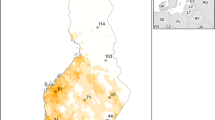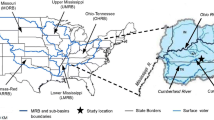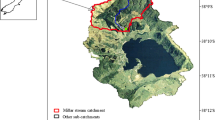Abstract
During the 19th and the first half of the 20th century, approximately 300 km2 of lakes and wetlands, representing 29% of the River Kavlingean catchment in Southern Sweden, were drained to make land available for agriculture. Published accounts of nutrient loads from the catchment indicated that until the mid 20th century, factories and urban point sources were the major contributors of both nitrogen and phosphorus. By the middle of the 20th century, the construction of sewage treatment plants had effectively reduced phosphorus pollution. Concurrently, the land drained in the previous century underwent a more intense cultivation, with productivity being maintained by commercial fertilizers. Subsequently, net nutrient loads from agriculture continued to increase, reaching an annual load of 2652 tons total-nitrogen and 70 tons total-phosphorus for the River Kävlingeån. Whilst high nutrient leakage from agricultural watersheds may be a problem which is only recently recognized, it had its origins in nearly a hundred years of commonly accepted agricultural policy.
To assess the importance of agriculture as the major source of nutrients to the River Kävlingeån system, three tributary catchment areas, differing in terms of their land use patterns (high, medium and low intensity of agricultural use), were studied and compared with literature figures. Results indicated that agricultural nutrient loss areal coefficients were substantially higher than the literature figures, demonstrating the role of agriculture as source of nutrients to the River Kävlingeån system. The agricultural land use policies of the last fifty years were revealed to be most important with regard to this role. Of such land use policies, the cultivation of the last 10–15% of land employed for agricultural use (primarily riparian ecotones) may be of most significance. The literature indicates that intense agricultural use of this final 10–15% may account for a ca. 50% increase in nitrogen loss. This suggests that one solution to the problem of agricultural diffuse pollution may lie in the restoration and sustainable management of riparian ecotones of agricultural streams.
Similar content being viewed by others
References
Ahl, T. & S. Odén, 1975. Nutrient sources — an overview. In Miljövårdssekretariatet (ed.), Eutrophication — 10th Nordic Symposium on Water Research. Nordforsk, Helsinki: 99–133.
Alström, K. & A. Bergman, 1988. Sediment and nutrient losses by water erosion from arable land in South Sweden. A problem with nonpoint pollution? Vatten 44: 193–204.
Andersson, R., 1981. Växtnäringsförluster från åkermark, kunskapsöversikt. In Naturvårdsverket (ed.), Hydrologi, Markanvändning, Vattenkvalitet. Rapport SNV PM 1455: 85–103.
Arnesson, S. I. & K. Elwér, 1987. Förslag till åtgärder för att minska den svenska föroreningsbelastningen på Öresund. Naturvårdsverket Rapport 3315, Länsstyrelsen i Malmö-hus län: 56 pp.
Berggren, H., 1986. Belastnings- och transportberäkningar. Föredrag vid FVH-möte i Halmstad, FVH-publikation 1986, 4: 23–26.
Brink, N., 1982. Närsalter och organiska ämnen från åker och skog. Ekohydrologi 14, Avdelningen för Vattenvård, SLU, Ultuna: 21–30.
Brink, N. & A. Gustafson, 1970. Nitrogen and phosphorus from forests, fields and cities. Vattenvård 1. Lantbrukshögskolan Uppsala: 108 pp.
Cooper, J. R., J. W. Gilliam, R. B. Daniels & W. P. Robarge, 1987. Riparian areas as filters for agricultural sediment. J. Soil. Sci. Soc. Am. 51: 416–421.
Emanuelsson, U. & J. Möller, 1990. Flooding in Scania: a method to overcome deficiency nutrients in agriculture during the 19th century. The Agricultural History Review 38, Part 2: 127–148.
Emanuelsson, U., C. Bergendorff, B. Carlsson, N. Lewan & O. Nordell, 1985. Det skånska kulturlandskapet. Signum, Lund: 248 pp.
Greenland, D. J., 1977. Soil damage by intensive cultivation: temporary or permanent? Phil. Trans. r. Soc. London. Ser. B 281: 193–208.
Groffman, P. M., G. J. House, P. F. Hendrix, D. E. Scott & D. A. Crossley Jr., 1986. Nitrogen cycling as affected by interactions of components in a Georgia Piedmont agroecosystem. Ecology 67: 80–87.
Gustavsson, A. S., 1985. Förluster av kväve och fosfor runt Ringsjön. Ekohydrologi 19, Avdelningen för Vattenvård, SLU, Ultuna: 36–43.
Ihse, M., 1985. Försvinnande biotoper i jordbrukslandskapet. Jämförande studie i flygbilder från 1940-talet till nutid i Ystadsområdet. In G. Regnell (ed.), Kulturlandskapet - dess framväxt och förändring. Växtekologiska institutionen, Lunds Universitet: 101–108.
Isenhart, T. M. & W. G. Crumpton, 1989. Transformation and loss of nitrate in an agricultural stream. J. freshw. Ecol. 5: 123–129.
Jeffries, M. & D. Mills, 1990. Freshwater Ecology — Principles and Applications. Belhaven Press, London & New York: 285 pp.
Joelsson, A. & A. Eha, 1983. Närsaltbidraget till vattendrag och kustvatten i Malmöhus län. Vatten 39: 286–295.
José, P., 1989. Long term nitrate trends in the river Trent and four major tributaries. Regulated Rivers, Research and Management 4: 43–57.
Karr, J. R. & I. J. Schlosser, 1978. Water resources and the land-water interface. Science 201: 229–234.
Kindblom, L., 1970. Sjösanknings- och torrläggningsföretag. In G. Wejman-Hane, L. Kindblom & A. Almestrand (eds), Vattenvårdsplan för Kävlingeån. KWPA, Malmö: 1–7.
Kävlingeåns Water Protection Association (KWPA), 1991. Sammanfattad vattendragskontroll för Kävlingeån. Käv-lingeåns vattenvårdsförbund, Malmö: 47 pp.
Larsson, U., R. Elmgren & F. Wulff, 1985. Eutrophication and the baltic sea: causes and consequences. Ambio 14: 9–14.
Longabucco, P. & M. R. Rafferty, 1989. Delivery of nonpointsource phosphorus from cultivated mucklands to Lake Ontario. J. envir. Qual. 18: 157–163.
Lowrance, R. R., R. T. Todd, J. Fail Jr., O. Hendrickson, Jr., R. Leonard & L. E. Asmussen, 1984. Riparian forests as nutrient filters in agricultural watersheds. BioScience 34: 374–377.
Lundegårdh, P. H., J. Lundqvist & M. Lindström, 1964. Berg och Jord i Sverige. Almqvist & Wiksell, Stockholm: 349 pp.
McCarthy, D. T., 1983. The impact of arterial drainage on fish stocks in the Trimblestone river. In C. Moriarty (ed.), Advances in Fish Biology in Ireland. Irish Fisheries Investigations, Series A 23: 16–19.
Mitsch, W. J. & J. G. Gosselink, 1986. Wetlands. Van Nostrand Reinhold Company, New York: 539 pp.
Neill, M., 1989. Nitrate concentrations in river waters in the South-East of Ireland and their relationship with agricultural practice. War. Res. 23: 1339–1355.
Ogawa, H. & J. W. Male, 1983. The flood mitigation potential of inland wetlands. Water resources Research Center Publication No. 138, University of Massachusetts, Amherst: 164 pp.
Ongley, E. D., 1982. The PLUARG experience: scientific implications for diffuse sources management. In: B. T. Hart (ed.), Water quality management. Monitoring programs and diffuse runoff. Water Studies Centre Chisholm Institute of Technology and Australian Society for Limnology, Melbourne: 87–101.
Pedrozo, F. & C. Bonetto, 1989. Influence of river regulation on nitrogen and phosphorus mass transport in a large South American river. Regulated Rivers, Research and Management 4: 59–70.
Persson, Å., 1976. Risbygd - Skogsbygd, vegetation och landskapsförändringar i Hörbytrakten. Skånes Natur Årsbok: 41–53.
Peterjohn W. T. & D. L. Correll, 1984. Nutrient dynamics in an agricultural watershed: observations on the role of a riparian forest. Ecology 65: 1466–1475.
Petersen, R. C. Jr., L.B-M. Petersen & J. O. Lacoursière, 1991. A building block model for stream restoration. In P. Boon, G. Petts & P. Calow (eds), The conservation and management of rivers. J. Wiley & Sons, N.Y. (In Press).
Petersen, R. C. Jr., B. L. Madsen, M. A. Wilzbach, C. H. D. Magadza, A. Paarlberg, A. Kullberg & K. W. Cummins, 1987. Stream management: emerging global similarities. Ambio 16: 166–179.
Pinay, G. & H. Decamps, 1988. The role of riparian woods in regulating nitrogen fluxes between the alluvial aquifer and surface water: a conceptual model. Regulated Rivers, Research and Management 2: 507–516.
Riksdagen, 1988a. Mijöpolitiken inför 90-talet. Proposition 1987/88: 85, Stockholm, 501 pp.
Riksdagen, 1988b. Om miljöförbättrande åtgårder i jordbruket m m. Proposition 1987/88: 128, Stockholm: 353 pp.
Risser, P. G., 1990. The ecological importance of land-water ecotones. In R. J. Naiman & H. Decamps (eds), The Ecology and Management of Aquatic-Terrestrial Ecotones. Man and the Biosphere series 4: 7–21.
Rosenberg, R., 1986. Eutrofieringsläget i kattegatt. National Swedish Environmental Protection Board. Report 3272, 150 pp.
Rosswall, T. & K. Paustian, 1984. Cycling of nitrogen in modern agricultural systems. Plant a. Soil 76: 3–21.
Sampl, H., 1986. Einfluss von Nährstoffabschwemmung und Bodenerosion auf die Gewässereutrophierung. Wasserwirtschaft Wasservorsorge. Bundesministerium für Land- und Forstwirtschaft, Wien: 33 pp.
Sondén, K., 1914. Anteckningar rörande svenska vattendrag: Kjevlingeån. P. A. Norstedt & Söner, Stockholm: 33–48.
Statistiska Centralbyrån, 1987. Lantbruksräkningen. SCB, Stockholm: 98 pp.
Swedish Meteorological and Hydrological Institute (SMHI), 1990. Klimatsammanställning Station M518 Lund och Medelvattenföring pegel 92–2126 Ellinge. SMHI, Stockholm, 2 pp.
Ulén, B., 1986. Fosforerosion vid vallodling och skyddszon med gräs. Ekohydrologi 20, Avdelningen för Vattenvård, SLU, Ultuna: 23–28.
Wejman-Hande, G., L. Kindblom & A. Almestrand, 1970. Vattenvårsplan för Kävlingeån. KWPA, Malmö: 105 pp.
Wiklander, L., 1970. Leaching of nutrients. Grundförbättring 23: 3–4.
Wiklander, L. & G. Hallgren, 1982. Leaching of nutrients 3. Grundförbättring 24: 3–4.
Wolf, P., 1960. Land drainage and its dangers as experienced in Sweden. John Sherratt & Son, Altrincham, Great Britain: 73 pp.
Wulff, F., G. AErtebjerg, G. Nicolaus, A. Niemi, P. Ciszewski, S. Schulz & W. Kaiser, 1986. The changing pelagic ecosystem of the Baltic Sea. Ophelia, Suppl. 4: 299–319.
Yates, P. & J. M. Sheridan, 1983. Estimating the effectiveness of vegetated floodplains/wetlands as nitrate-nitrite and orthophosphorus filters. Agric, Ecosystem and Environment 9: 303–314.
Zachrisson, A., 1914. Nyodling, torrläggning och bevattning i Skrane. Skrifter utgivna av de skånska hushållningssäll-skapen med anledning av deras hundraårsjubileum. Gleerups, Lund: 32 pp.
Author information
Authors and Affiliations
Rights and permissions
About this article
Cite this article
Krug, A. Drainage history and land use pattern of a Swedish river system — their importance for understanding nitrogen and phosphorus load. Hydrobiologia 251, 285–296 (1993). https://doi.org/10.1007/BF00007188
Issue Date:
DOI: https://doi.org/10.1007/BF00007188




